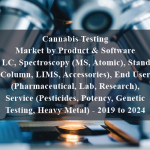OVERVIEW
The Bio Decontamination Market is currently valued at USD 238 million in 2024 and will be growing at a CAGR of 7.3% over the forecast period to reach an estimated USD 339 million in revenue in 2029. The bio decontamination market is a vital sector within the broader field of environmental and healthcare services, focusing on the elimination or reduction of harmful biological agents from various environments. It encompasses a range of products and services designed to sanitize and sterilize spaces, equipment, and surfaces to prevent the spread of pathogens, including bacteria, viruses, fungi, and spores. With the increasing awareness of infectious diseases and the growing emphasis on hygiene and safety across industries such as healthcare, pharmaceuticals, food and beverage, and research laboratories, the bio decontamination market is witnessing significant growth. Technologies such as hydrogen peroxide vapor, ozone, UV-C light, and chemical disinfectants are commonly utilized for bio decontamination purposes, offering efficient and reliable solutions to ensure clean and safe environments. As regulatory standards become more stringent and the demand for effective decontamination methods rises, the market is expected to expand further, driven by innovation and the continuous quest for advanced bio-cleaning solutions.
Foremost among these is the increasing prevalence of infectious diseases worldwide, driving the demand for effective methods to eliminate pathogens and ensure hygienic environments. Additionally, stringent regulatory standards and guidelines in industries such as healthcare, pharmaceuticals, and food and beverage are compelling organizations to invest in robust bio decontamination solutions to maintain compliance and safeguard public health. Moreover, advancements in technology, such as the development of novel decontamination techniques and the introduction of automated systems, are enhancing the efficiency and efficacy of bio decontamination processes, further fueling market growth. Furthermore, the ongoing COVID-19 pandemic has heightened awareness about the importance of thorough disinfection practices, leading to a surge in demand for bio decontamination services and products across various sectors. As a result, the bio decontamination market is expected to continue expanding as businesses and institutions prioritize cleanliness and infection control measures.
Table of Content
Market Dynamics
Drivers:
Foremost among these is the increasing prevalence of infectious diseases worldwide, driving the demand for effective methods to eliminate pathogens and ensure hygienic environments. Additionally, stringent regulatory standards and guidelines in industries such as healthcare, pharmaceuticals, and food and beverage are compelling organizations to invest in robust bio decontamination solutions to maintain compliance and safeguard public health. Moreover, advancements in technology, such as the development of novel decontamination techniques and the introduction of automated systems, are enhancing the efficiency and efficacy of bio decontamination processes, further fueling market growth. Furthermore, the ongoing COVID-19 pandemic has heightened awareness about the importance of thorough disinfection practices, leading to a surge in demand for bio decontamination services and products across various sectors. As a result, the bio decontamination market is expected to continue expanding as businesses and institutions prioritize cleanliness and infection control measures.
Key Opportunities:
The bio decontamination market presents several key opportunities for growth and innovation. One significant opportunity lies in the development of eco-friendly and sustainable decontamination solutions, as there is an increasing emphasis on environmental stewardship and the use of non-toxic, biodegradable alternatives. Additionally, the expansion of the market into emerging economies offers immense potential, as these regions are witnessing rapid industrialization and urbanization, driving demand for effective sanitation and hygiene solutions. Moreover, the integration of digital technologies such as IoT, artificial intelligence, and data analytics into bio decontamination processes opens up opportunities for real-time monitoring, predictive maintenance, and optimization of decontamination protocols. Furthermore, the rising adoption of bio decontamination services in non-traditional sectors such as transportation, hospitality, and residential spaces presents untapped markets for growth. By capitalizing on these opportunities and fostering innovation, companies operating in the bio decontamination market can position themselves for long-term success and market leadership.
Restraints:
One significant challenge is the high initial investment required for implementing advanced decontamination technologies and systems, which can act as a barrier to entry for smaller businesses and organizations with limited budgets. Additionally, the complexity and variability of bio decontamination processes, especially in large-scale facilities or complex environments, can pose logistical challenges and increase operational costs. Moreover, concerns regarding the potential toxicity or long-term effects of certain disinfection agents on human health and the environment may hinder widespread adoption, particularly in industries where safety and sustainability are paramount. Regulatory hurdles and the need for stringent validation and compliance with industry standards further add to the complexities of navigating the bio decontamination market landscape. Addressing these restraints will require ongoing research and development efforts to enhance affordability, efficiency, and safety while also fostering greater awareness and acceptance of bio decontamination practices among diverse stakeholders.
Regional Information:
• In North America, the bio decontamination market is driven by stringent regulatory standards and a strong emphasis on infection control across various sectors, particularly healthcare and pharmaceuticals. The region boasts a mature healthcare infrastructure and a high level of awareness regarding the importance of sanitation and hygiene, leading to robust demand for advanced decontamination technologies and services. Additionally, the presence of leading players and technological innovators in the United States and Canada contributes to the continuous evolution and adoption of cutting-edge bio decontamination solutions.
• In Europe, the bio decontamination market benefits from a similar regulatory environment and a culture of stringent quality control measures, particularly in industries such as healthcare, biotechnology, and food processing. Countries like Germany, France, and the United Kingdom are key contributors to market growth, driven by investments in research and development, as well as a growing focus on sustainability and environmental responsibility. Moreover, the presence of established players and a well-developed healthcare infrastructure further support the expansion of the bio decontamination market in the region.
• In the Asia Pacific region, rapid industrialization, urbanization, and increasing healthcare expenditure are driving significant growth opportunities for the bio decontamination market. Countries like China, Japan, and India are witnessing growing demand for bio decontamination solutions, fueled by a rising awareness of infectious diseases, hygiene standards, and the need for quality assurance in sectors such as healthcare, pharmaceuticals, and food safety. Moreover, government initiatives aimed at improving healthcare infrastructure and sanitation standards are further bolstering market growth in the region.
Recent Developments:
• In July 2022, Ecolab’s (US) Bioquell HPV-AQ received an authorized approval for use in all territories of the European Union and the European Economic Area.
• In Dec 2022, the TOMI Environmental Solutions, Inc (US) launched new SteraMist products, which include the Select Plus-a hybrid product consisting of the Company’s current Surface Select and Environment systems. (The system is 24 volts, allowing for universal outlet usage and convert more of the hydrogen peroxide BIT Solution to hydroxyl radicals thus lowering H2O2 PPM levels allowing for faster turnaround time).
Key Market Players:
Steris Corporation, Ecolab Inc., Bioquell Inc., TOMI Environmental Solutions, Cantel Medical, Decon Environmental Services Ltd., Fedegari Autoclavi S.p.A., Zhejiang Tailin Bioengineering Co., Ltd., Halma plc (Bioquell), Synergy Health plc.
Frequently Asked Questions
1) What is the projected market value of the Bio Decontamination Market?
– The Bio Decontamination Market is expected to reach an estimated value of USD 339 million in revenue by 2029.
2) What is the estimated CAGR of the Bio Decontamination Market over the 2024 to 2029 forecast period?
– The CAGR is estimated to be 7.3% for the Bio Decontamination Market over the 2024 to 2029.
3) Who are the key players in the Bio Decontamination Market?
– Steris Corporation, Ecolab Inc., Bioquell Inc., TOMI Environmental Solutions, Cantel Medical, Decon Environmental Services Ltd., Fedegari Autoclavi S.p.A., Zhejiang Tailin Bioengineering Co., Ltd., Halma plc (Bioquell), Synergy Health plc.
4) What are the drivers for the Bio Decontamination Market?
– The increasing prevalence of infectious diseases worldwide, stringent regulatory standards, advancements in technology, and the COVID-19 pandemic have driven demand for effective bio decontamination solutions. The market is expected to continue expanding as businesses prioritize cleanliness and infection control measures, with advancements in technology and novel decontamination techniques enhancing efficiency.
5) What are the restraints and challenges in the Bio Decontamination Market?
– The high initial investment for advanced decontamination technologies can hinder entry for smaller businesses, while the complexity and variability of bio decontamination processes can increase operational costs. Concerns about potential toxicity and regulatory hurdles further complicate the market. Addressing these challenges requires ongoing research to improve affordability, efficiency, safety, and acceptance of bio decontamination practices.
6) What are the key applications and offerings of the Bio Decontamination Market?
– Healthcare facilities, pharmaceutical manufacturing, food processing, and research laboratories all require sterile environments to prevent infections, maintain product quality, eliminate pathogens, and protect researchers from hazardous materials.
7) Which region is expected to drive the market for the forecast period?
– North America is expected to have the highest market growth from 2024 to 2029
Why Choose Us?
Insights into Market Trends: Global Market Studies reports provide valuable insights into market trends, including market size, segmentation, growth drivers, and market dynamics. This information helps clients make strategic decisions, such as product development, market positioning, and marketing strategies.
Competitor Analysis: Our reports provide detailed information about competitors, including their market share, product offerings, pricing, and competitive strategies. This data can be used to inform competitive strategies and to identify opportunities for growth and expansion.
Industry Forecasts: Our reports provide industry forecasts, which will inform your business strategies, such as investment decisions, production planning, and workforce planning. These forecasts can help you to prepare for future trends and to take advantage of growth opportunities.
Access to Industry Experts: Our solutions include contributions from industry experts, including analysts, consultants, and subject matter experts. This access to expert insights can be valuable for you to understand the market.
Time and Cost Savings: Our team at Global Market Studies can save you time and reduce the cost of conducting market research by providing comprehensive and up-to-date information in a single report, avoiding the need for additional market research efforts.











